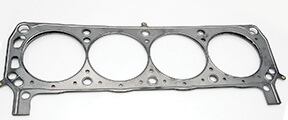Seal a leaking head gasket
Will sodium silicate seal a leaking head gasket?
In some cases, sodium silicate can temporarily seal a leaking head gasket. But there are many downsides to using a liquid head gasket sealer. Read on for more information.
What is sodium silicate?
Sodium silicate (Na2SiO3) is a combination of sodium carbonate and silicon dioxide. In a powered state it looks like table sale. But when you dissolve it in water heated to 210°F to 220°F it melts into a very thin glass layer. That’s why it’s often used to seal head gaskets.
When you add it to your engine’s coolant, it circulates  through the system and melts on hot sharp edges. That’s great if your head gasket leaking because of a breach of the head gasket near the cylinder. If the metal ring on the head gasket that surrounds the cylinder is breached to form an opening between the cooling jacket and the cylinder, sodium silicate may work to seal the breach. As the sodium silicate melts out of solution, it continues to deposit around the hot spot and can seal gaps up to 1/16”.
through the system and melts on hot sharp edges. That’s great if your head gasket leaking because of a breach of the head gasket near the cylinder. If the metal ring on the head gasket that surrounds the cylinder is breached to form an opening between the cooling jacket and the cylinder, sodium silicate may work to seal the breach. As the sodium silicate melts out of solution, it continues to deposit around the hot spot and can seal gaps up to 1/16”.
Sounds good so far, right? Well, don’t breathe a sigh of relief just yet. This glass layer is very fragile and the expansion/contraction the engine sees from cold startup to full operating temperature can cause the glass to crack.
Also, if your head gasket leak is due to cylinder head warping from overheating or you’ve got a gasket breach between an oil gallery and the cooling jacket this type of sealer won’t work because there isn’t enough heat to activate it.
For more information on what causes head gasket leaks, see this post
But head gasket sealers cause other problems
All cooling system and head gasket sealers have the potential to clog your car’s heater core and radiator. The clogging happens not because the sodium silicate has found a hot spot, but because it settles out of solution and deposits in small passages. The best way to screw up your heater core and radiator is to not follow the manufacturer’s instruction to the letter.
Most DIYers add too much sealer. And, because many of these sealers work best with water, the manufacturers want you to drain the coolant and refill with plain water before adding the sealer. Skip this step and you’ll screw everything up.
Other manufacturers say you can use their sealers with your coolant. But they’re assuming you’re using the recommended coolant. So check the sealer manufacturer’s recommended coolant type against what you’ve actually got in your vehicle. If your coolant isn’t compatible with the sealer, you’re going to have a much bigger problem on your hands.
Does head gasket sealer work?
Sealers come in two varieties, plugging and melting. Sodium silicate is the melting variety and it has a much better chance of sealing a head gasket breach between the cylinder and the cooling jacket than the plugging type. Even then it’s considered a temporary fix. It will NOT last forever. There’s simply too much expansion/contraction/vibration/pressure going on inside your engine. In a best case scenario, it works less than 50% of the time. The melting sealers rarely work on a warped cylinder head that’s caused by overheating. If your head gasket starting leaking after an episode of overheating, you’re kidding yourself if you think a bottle of liquid sealer will fix the problem.
The plugging types almost never work.
The best way to fix a leaking head gasket is to remove the cylinder head and replace the gasket.
©, 2019 Rick Muscoplat
Posted on by Rick Muscoplat